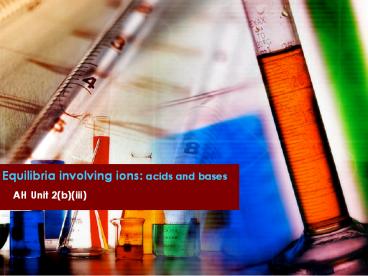Equilibria involving ions: acids and bases PowerPoint PPT Presentation
Title: Equilibria involving ions: acids and bases
1
Equilibria involving ions acids and bases
- AH Unit 2(b)(iii)
2
Key question
- What is are acids and bases?
3
Arrhenius definition
- An acid is a substance that when added to water
increases the concentration of H(aq) ions. - HA (aq) ? H(aq) A-(aq)
- A base is a substance that when added to water
increases the concentration of OH-(aq) ions. - BOH (aq) ? B(aq) OH-(aq)
4
Key question
- What are the limitations of these definitions?
5
(No Transcript)
6
Bronsted-Lowry definitions
- An acid is a proton donor.
- HA ? H A-
- HA H2O ? H3O A-
- A base is a proton acceptor.
- B H ? BH
- B H3O ? BH H2O
7
Hydronium ion
8
Conjugate acids and bases
9
Ionisation of water
- Water is amphoteric.
- Can you write an expression for the equilibrium
constant?
10
Ionic product of water
- Kw has a value of 1 x 10-14 at 25ºC.
- Known as the ionic product of water.
- Value varies with temperature.
11
pH scale
12
Dissociation of acids
This is a measure of the strength of an acid -
the larger the value of Ka, the stronger the acid.
13
Calculating pH of weak acids
14
Dissociation of bases
This is a measure of the strength of a base - the
larger the value of Ka, the weaker the base.
15
Indicators
16
Universal indicator
17
Methyl orange
18
Phenolphthalein
19
Indicators
- Are weak acids
20
- HIn and In- have different colours
- Their ratio is dependant on H3O
- The colour of an indicator in any given solution
therefore depends on the ratio, which in turn is
determined by pH
21
- The theoretical point at which the colour change
occurs is when HIn In- - Therefore the colour change occurs when
KIn H3O - pKIn pH
22
- In practice, the colour change is not visible
when HIn In- - Instead, they must differ by a factor of 10
- i.e. when H KIn 10
- OR when pH pKIn 1
23
Choice of indicator
- Colour change must occur as close to the
equivalence point as possible. - Equivalence point the point at which all of the
acid has been exactly neutralised by all of the
alkali. - Does this always occur at pH 7?
24
Methyl red
25
Phenolphthalein
26
- The colour chance must occur in the region of
rapid pH change. - This means that the addition of half a drop of
acid/base will cause a colour change. - The choice of indicator must therefore be made
with reference to titration curves.
27
Strong acid / strong base
28
(No Transcript)
29
Phenolphthalein
30
(No Transcript)
31
Examples
32
Practice
33
Buffers
34
Buffer solutions
- Is a solution where the pH remains approximately
constant when small amounts of acid or bases are
added. - Common examples
- blood
- sea water
35
Acid buffers
- Consists of a weak acid with one of its salts (of
a strong alkali) - e.g. ethanoic acid sodium ethanoate
- The acid is partially dissociated and equilibrium
with its ions. - The salt is fully ionised.
36
- Addition of alkali
Supplies H3O(aq) ions if any removed in reacting
with an added base.
- Addition of acid
CH3COONa(s) ? Na(aq) CH3OO-(aq)
The conjugate base removes any added H(aq)
37
(No Transcript)
38
pH of buffer solutions
Because the by diluting a buffer the
concentration of acid and salt will decrease in
proportion, dilution will not affect the pH of a
buffer solution.
39
Practice
40
Basic buffers
- Consist of a weak base with one of its salts (of
a strong acid).

